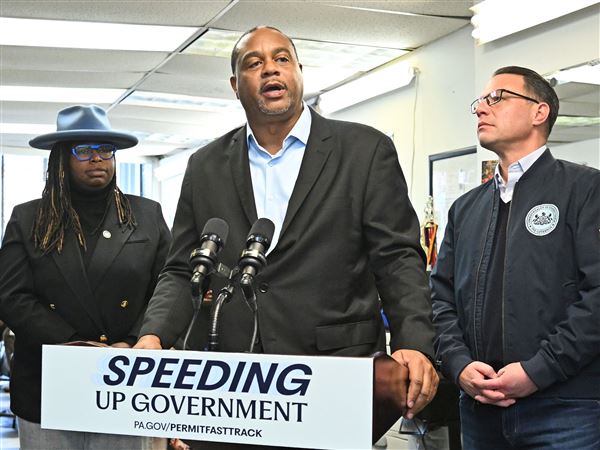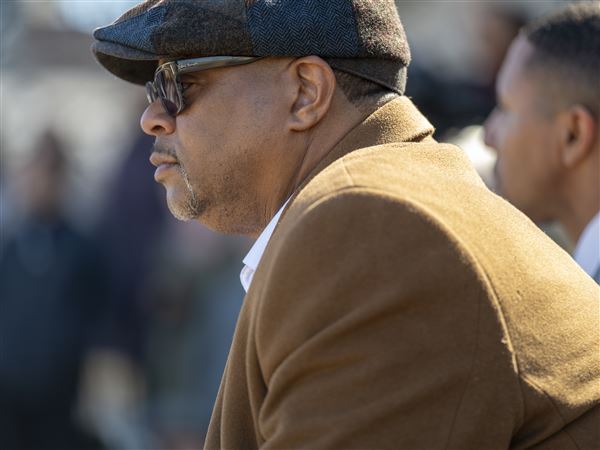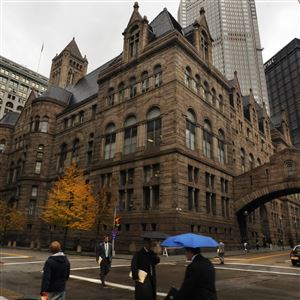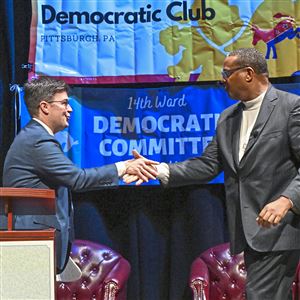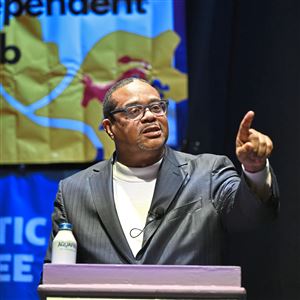On a Sunday afternoon during primary election season, dozens of candidates set up tables and chairs in the ever-unpredictable Pittsburgh weather for last-minute lobbying to earn the coveted endorsement of the Allegheny County Democratic Committee.
Many candidates have shelled out hundreds or even thousands of dollars in campaign funds to even be considered for the committee’s nod.
Last Sunday, Allegheny County Controller Corey O’Connor won the endorsement from the county committee over incumbent Mayor Ed Gainey by just four votes — a margin so close the committee decided to do a recount.
Mr. O’Connor’s win held up during the recount but it’s unclear if the endorsement will sway voters beyond bragging rights for the candidate.
The Republican Committee of Allegheny County so far has not endorsed either of the GOP candidates in the mayor’s race: businessman Thomas West and former city police officer Tony Moreno.
In the past, election winners often could be predicted based on their endorsements. Party and union leadership were the deciding factors in how people would vote. Now endorsements more commonly signal how a candidate will govern.
For candidates, being acknowledged by their party, unions and issue-based advocacy groups can open a world of assistance for their campaigns, from canvasses to help spread their message to monetary donations.
Union endorsements can often signal to voters where the candidates stand on a particular issue, said Democratic strategist Mike Butler. In the past few years, an endorsement from SEIU Healthcare has signaled a progressive candidate. Other unions, like the Pennsylvania Laborers’ District Council, tend to back candidates with more centrist, business-friendly policies.
The endorsement itself isn’t the important part, according to Mr. Butler, who has worked on numerous local, state and federal campaigns. “It was a signal of the candidate's values.”
The value of the endorsement to voters also differs depending on where the endorsement comes from and what office the candidate seeks. Down-ballot races often attract candidates who are not well-known to the public, while races for offices such as Pittsburgh mayor tend to draw politicians who already are household names.
“The higher profile the race, the less important [the endorsement is],” said Mr. Butler.
When voters know a candidate, their opinions are often already set, he added. For some voters, it doesn’t matter what group endorses or doesn’t endorse a candidate, their minds are made up.
For lower-profile contests like county judicial races, the endorsement goes a long way for voters. Candidates for judge can’t make campaign promises for what they would do on the bench, according to state law.
When candidates don’t have a political record to look back on, it can be difficult for voters to determine whom to vote for. It’s much easier to look to organizations that have beliefs they align with, and that have a detailed evaluation process for candidates that can include interviews and long questionnaires.
Steel City Stonewall Democrats, for one, presses candidates on their support for LGBTQ+ issues. On the right, Firearm Owners Against Crime focuses on candidates who promise to protect Second Amendment rights.
“When [voters are] trying to select from a large pool of people … it’s really good to know that other people have vetted those candidates,” said Karen Hochberg, the immediate past president of the 14th Ward Independent Democratic Committee.
As of last Tuesday – the deadline for nominating petitions to be filed with the county – there were 22 candidates for eight open judicial seats in Common Pleas Court. The average voter doesn’t have the time – nor, often, the desire – to vet 22 candidates on their own, Ms. Hochberg said.
That’s where the endorsement comes in.
“If a candidate goes before a community group or a civic group and they decide they want to endorse, that to me has some value to it,” Ms. Hochberg said, because that means candidates have explained their positions in a way that appealed to the organization’s values.
The 14th Ward — which is home to neighborhoods such as Squirrel Hill, Point Breeze, parts of Oakland and Swisshelm Park — does just that. Each spring, the group hosts a fundraising event where committee members get to meet the candidates “in a relaxed setting,” Ms. Hochberg said.
After it decides its endorsements, the group sends out its famous yellow mailer that lists all the endorsed candidates.
Ms. Hochberg said she has seen voters bring that mailer to the polls – particularly in off-year elections when voters aren’t inundated for months with political commercials, mailers and relentless media coverage of the candidates.
“People literally bring it with them to inform their vote,” she said.
The 14th Ward committee — the largest in the city — won’t endorse a candidate in the mayor’s race until April.
It’s unclear whether it will follow the lead of the county party, which broke from the common practice of endorsing the current officeholder.
“It’s unusual for the party to reject their own incumbents,” said Mr. Butler.
But not getting an endorsement can sometimes work to a candidate’s advantage.
Mr. Gainey can use the committee’s snub to position himself as the candidate outside the establishment, Mr. Butler said — a standing that appeals to many progressive Democrats.
The importance of the county Democratic Committee endorsement has long been debated. Each election cycle it is lauded as a rite of passage for Democrats in the county and known as the institutional stamp of approval. But critics of the committee often claim it is outdated and doesn’t match the opinions of Democrats on the ground.
“There have been plenty of candidates that don’t get the endorsement and go on to win,” Mr. Butler said, citing the committee’s 2023 endorsement in the Allegheny County executive primary.
Former county Treasurer John Weinstein won the party’s backing, though Sara Innamorato went on to win the primary and general elections.
But committee members are taking steps to improve the endorsement process, Ms. Hochberg among them.
There’s been a years-long push to update the committee’s bylaws, which haven’t been revised since 2009, Ms. Hochberg said.
Members are proposing changing the endorsement threshold from a plurality (whoever has the greatest number of votes) to a majority (more than 50%) of the votes.
By either method, the vote for this year’s endorsement was razor-thin — not surprising for a race between two candidates who have been involved in politics in the region for years and have “long-standing ties” with many committee members, Mr. Butler said.
Unions, too, have been picking sides in the hard-fought contest between Mr. Gainey and Mr. O’Connor. The United Steelworkers have thrown their weight behind Mr. Gainey, while Mr. O’Connor racked up a number of labor endorsements in February, including local units of the Teamsters and Steamfitters.
Notably missing from endorsements so far this cycle is the Service Employees International Union. The SEIU heavily backed Mr. Gainey during his first run for mayor, but its involvement this year has been limited to a $2,500 contribution from the group’s political arm and another $3,500 from Executive Vice President Neal Bisno to Mr. Gainey’s campaign.
Candidates know the endorsements aren’t “a defining path to victory” anymore, Mr. Butler said, but they’re still useful tools for campaigning.
In 2021, when Mr. Gainey had the support of labor and service unions across the state, he prominently displayed his endorsements on his campaign website. This time around, after some unions— including the International Union of Painters and the Allied Trades local unit — flipped their support to Mr. O’Connor, the endorsement page is no longer linked on his website.
But shortly after announcing the backing of the United Steelworkers, Mr. Gainey’s fundraising emails cited the union's support as a reason for others to donate to his campaign.
“The Steelworkers built the city of Pittsburgh, and I am so grateful to have their support as we approach May’s primary,” one email said.
In a sharp contrast to Mr. Gainey’s campaign site, Mr. O’Connor has put his endorsements front and center, splashing the support of 14 unions and political committees across the landing page of his website.
Those groups might not hold the same sway they did generations ago, Mr. Butler said, “but it does help shape their narrative of how well their campaign is going.”
First Published: March 16, 2025, 9:30 a.m.
Updated: March 17, 2025, 3:01 p.m.
